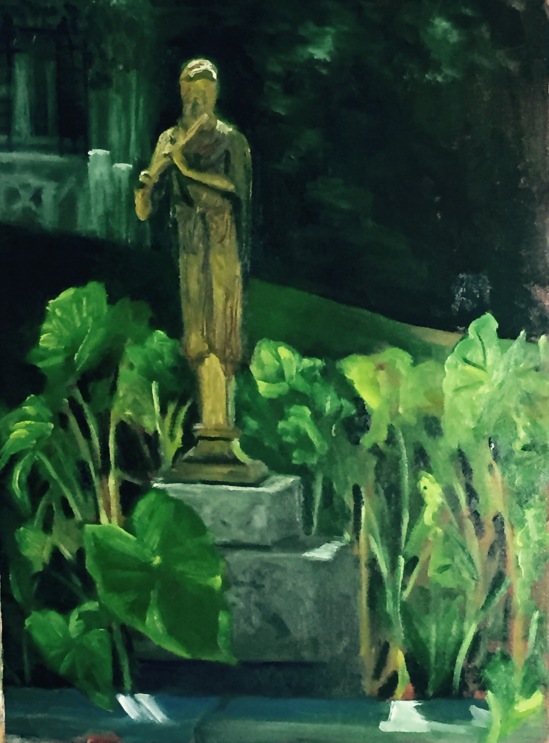I have, from time to time, complained about fog or glare appearing in my photographs of artwork. I tried to eliminate glare by cutting down on lighting, but it didn’t always work. The larger the painting, the harder it was to eliminate glare. When I started, I didn’t have a lot to photograph so I would take the artwork outdoors to a spot where the lighting was indirect. As I accumulated piles of panels to photograph, I wanted to be able to run through them relatively quickly–indoors and at night. I would flood the studio with full-spectrum artificial light. Instead of aiming lights at the artwork, I would bounce light off the ceiling, through a mirror, etc. I thought the only solution was to avoid the light that rakes across the surface of a painting. Yet my research on the internet kept producing advice to set up lamps aimed at 90 degrees from the artwork.
The result of my low lighting solution to glare was unsatisfactory color capture. I started using my iPhone instead of my once expensive, leading edge digital SLR Nikon D70. But all that is in the process of changing, since I attended a short workshop at the NH Institute of Art, conducted by the chairman of its Photograpy Department, Gary Samson. I learned a new concept: polarization. I’m no scientist, as Republican climate-change skeptics are so fond of saying, so the explanation that follows may read like a Mother Goose tale to someone who actually understands the physics of light.
Rays of light have direction, and bounce off surfaces like oil paintings. To polarize these bounces is to neutralize them, or counteract them, with filters that somehow deflect the bounces before they reach the camera. You need a filter for the camera lens. You also need filters between the light source and the art object.
I started by acquiring a filtering lens for the Nikon, and rephotographing some recent works that had troubled me. Despite the fact that I could not figure out exactly what I was supposed to see through my new circular filter, the photographs did improve. Compare the original hazy image with the new polarized image.

John Brown, posing as gardener or farmer (FOG FROM REFLECTED LIGHT)

John the Gardener (NO MORE FOG; COLOR ALSO MORE ACCURATE)
But then I tried to rephotograph a painting that I had varnished with a high gloss varnish. I could not get rid of the glare. So I rummaged around Amazon and then eBay until I found affordable gizmos to hang filters from the spotlights, and a large sheet of polarizing film from which to cut out sheets to hang from the gizmos. I don’t think it mattered whether the film’s polarity was circular, as with the camera lens, or parallel. Circularity was necessary for the camera so that the camera could still autofocus. I take that on faith since I don’t understand it.
Alas, the filters for the spotlights did not solve the varnish issue. I am so sad.
Two other advances in my photo technique have resulted from that workshop: I set the Nikon to take the photos in RAW format. That’s super-large format to accommodate enormous amounts of data for the purpose of manipulating the data in the finished version (jpeg) of the photo; and I bought a photo manipulating program better than “Photos”, which comes free with all my Apple devices. Adobe Lightroom, about $145 from Amazon, compatible with Macs and IOS. Headache! Powerful software equals massive learning curve, and hey, I hated learning how to operate the remote control on my DVR.
As a result of all this upheaval, my diligence with blogging faltered over the past couple of months. I’m hoping that by the end of January, I’ll have all the bugs worked out. Meanwhile, here is a decent photo of a 16×20 painting that I did over the summer–from a reference photo I took in my neighborhood.

Russell Street Roofs
Reminder for folks in the Chesapeake Bay area: see two of my animal portraits at the Annmarie Sculpture Gardern and Art Center in Solomons, Maryland. The exhibit’s theme is “Fur, Feathers, and Fins–Our Faithful Pets”. It will run through January 29.
Other places where you might catch a few of my paintings are:
- NH Antiques Coop in Milford NH
- Ellis River Art Gallery in Jackson NH (in January 2017)
- Bartlett Inn in Bartlett NH
- Red Jacket Resort in North Conway NH
- Bernerhof Inn in Glen NH
- Mesmer & Deleault Law Firm in Manchester NH
As usual, you may view paintings with prices and order prints, phone cases, pillows and the like at my Fine Art America page. If the painting you are interested in is not there, or if you prefer to bypass that experience, you may contact me by email to alotter@mac.com.
If you want to add a public comment to this blog, go to the bottom of this page where it says “Leave a Reply”, and enter your comment in that box. I love to get public comments, so don’t be shy!











